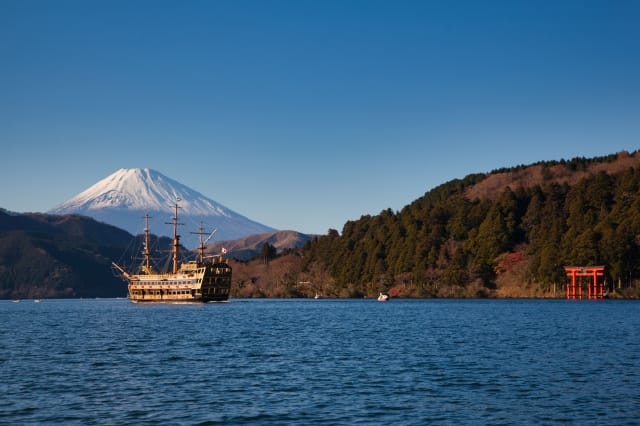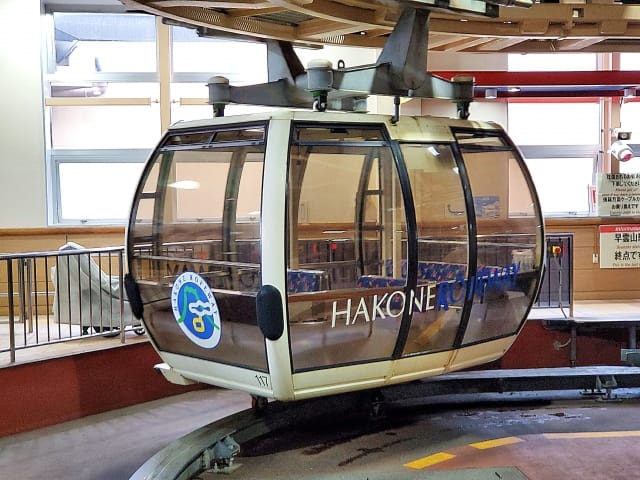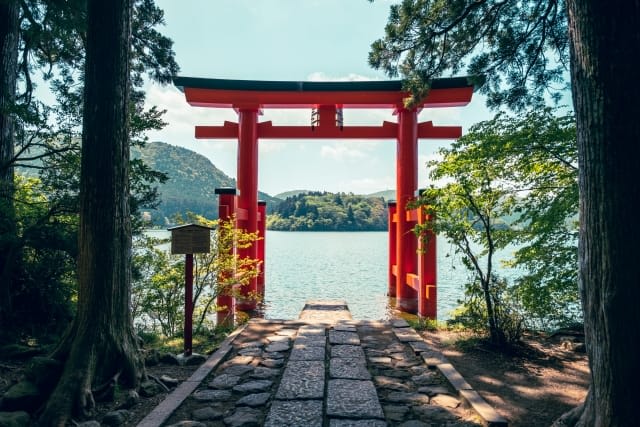8 Best Photo Spots in Hakone 2025: A Complete Photography Guide for Foreign Visitors
Hakone is one of my favorite photo spots. Just about 90 minutes from the city center, you'll encounter nature that changes with the seasons, world-class museums, and above all, the majestic Mt. Fuji.
It's true that weekends can be crowded with tourists, and depending on the weather, Mt. Fuji might be hidden in fog. But this "luck" is part of Hakone's charm.
If you visit early in the morning, you might have the large torii gate floating in the morning mist all to yourself. There are countless moments that make you want to press the shutter: Mt. Fuji reflected in Lake Ashi, the sunset coloring the pampas grass fields, and snow-covered winter landscapes.
In this article, I'll introduce you to the gem photo spots I've discovered over more than a decade of visits, along with the best shooting times and seasons. Come to Hakone and find your perfect shot!
Throughout Japan, including Hakone, Magical Trip offers guided tours where you can explore local history, traditions, and food culture in depth with local guides.(Hakone Full Day Chartered Private Tour: Art & Nature)
Our most popular tour "Tokyo Bar Hopping Night Tour in Shinjuku" was ranked as Tripadvisor's #1 tour in 2024.

For tourists visiting Tokyo, why not try a private car tour that lets you efficiently visit multiple attractions in a single day? With expert guides who know all the best spots, you can fully experience the region's traditions and rich food culture even in just one day.
These tours include hotel pickup and drop-off service, allowing you to visit attractions stress-free and efficiently. If you're interested in nature-rich destinations like Hakone and want to explore Japan's history and traditions while avoiding crowds, these tours are perfect for you.
・Hakone Full Day Chartered Private Tour: Art & Nature
・Mt. Fuji Full-day Nature Guided Tour with a Private Chartered Car & Guide
Table of Contents
・The Appeal of Hakone as a Photo Spot
・Photo Spots with Mt. Fuji Views
・Unique Photo Spots in Harmony with Nature
・Photo Spots Evoking History and Tradition
・Frequently Asked Questions About Hakone's Photo Spots
The Appeal of Hakone as a Photo Spot

Access from Tokyo to Hakone is smooth, taking about 90 minutes using the Odakyu Romance Car. Despite its proximity, Hakone offers views that seem like a different world, making it an ideal location for photography enthusiasts.
What I particularly like is how Hakone's landscape shows different expressions throughout the day. You can capture completely different atmospheres in your photos: Mt. Fuji shining in the morning sun, museums in the afternoon, and Lake Ashi at dusk.
Especially during the golden hours of morning and evening, soft light paints Hakone's scenery in a fantastic way, allowing for impressive shots.
Photo Spots with Mt. Fuji Views
Mt. Fuji, the star attraction of Hakone. You can photograph different expressions of Mt. Fuji from various locations. Here are my favorite spots.
Lake Ashi and Mt. Fuji

Lake Ashi is my most beloved photo spot in Hakone. On clear days, you can see Mt. Fuji reflected in the lake surface, a mystical view that takes your breath away. The red hull of the pirate ship moving across the lake with Mt. Fuji in the background is a popular subject, creating a unique Hakone scene.
The lakeside promenade is an excellent point for photographing Mt. Fuji from various angles. Especially at sunrise or sunset, the sky and lake surface turn red, allowing for fantastical atmosphere photos. In winter, the contrast between the snow-capped Mt. Fuji and the deep blue lake surface is spectacular, attracting many photographers.
Access: The Hakone Tozan Bus conveniently covers stations throughout the Lake Ashi area
Hakone Ropeway

The view from the Hakone Ropeway is simply breathtaking. From the summit, a 360-degree panoramic view spreads out, and on clear days, you can feel Mt. Fuji up close. The observation deck at the summit is spacious, allowing you to take your time considering compositions for your shots.
The collaboration of nature through the seasons with Mt. Fuji is exceptional. The scenery shows different expressions each season: fresh greenery in spring, deep green in summer, autumn foliage, and snowy landscapes in winter.
Website: https://www.hakonenavi.jp/hakone-ropeway/
Access: The starting point on the Gora side, Sounzan Station, is conveniently accessible by transferring from the Hakone Tozan Cable Car
Owakudani

Owakudani is one of the most impressive photo spots in Hakone. The contrast between the rising steam and Mt. Fuji creates a unique scenery typical of Japan's volcanic regions. While you can take great photos from the ropeway window, I recommend shooting from the observation deck.
Photographing the famous black eggs with Mt. Fuji will give you a unique shot filled with Hakone's essence. The hot spring steam rising from the earth becomes a subject that makes you feel the power of nature. Especially in winter, the combination with the snow-capped Mt. Fuji is spectacular, attracting many photographers.
Access: From Hakone-Yumoto Station, take the Hakone Tozan Bus (T line) for about 41 minutes to "Togendai" bus stop, transfer to Hakone Ropeway (bound for Owakudani) for about 16 minutes, get off at "Owakudani Station"
Unique Photo Spots in Harmony with Nature
In Hakone, there are also unique places where art and nature are beautifully harmonized. You can take attractive photos unique to each location.
The Hakone Open-Air Museum

The Open-Air Museum, where outdoor sculptures are scattered across a vast site in harmony with nature, is a dream-like place for photographers. The seasonal landscapes color the sculptural works, showing different expressions each season.
The sight of children interacting with the artworks also becomes an attractive subject, making it ideal for creating family memories. I especially recommend visiting first thing in the morning. The sculptures gleaming with morning dew are exceptionally beautiful.
Website: https://www.hakone-oam.or.jp/en/
Access: From Hakone-Yumoto Station, take the Hakone Tozan Line (bound for Gora) for about 35 minutes, get off at "Chokoku-no-Mori Station", 2-minute walk. Or, from Gora Station, take the Sightseeing Facility Circular Bus (S line) for about 3 minutes, get off at "Chokoku-no-Mori" bus stop
Admission: Adults: 2,000 yen, High School/Vocational/University Students: 1,600 yen, Junior High/Elementary School Students: 800 yen
Hakone Venetian Glass Museum

The Hakone Venetian Glass Museum, where you can encounter Venetian glass art, is a special place to photograph the beauty woven by light and shadow. The natural light entering the museum reflects off the glass works, creating a sparkle like jewels.
The seasonal special exhibitions are not to be missed. My personal favorite is the European-style garden. The exotic scenery makes you forget you're in Japan. In winter, you can also enjoy fantastical illuminations, perfect for night photography.
Website: https://www.hakone-garasunomori.jp/en/
Access: From Hakone-Yumoto Station, take the Hakone Tozan Bus (T line) for about 22 minutes, get off at "Hyoseki/Hakone Glass no Mori Mae" bus stop
Admission: Adults: 1,800 yen, University/High School Students: 1,300 yen, Junior High/Elementary School Students: 600 yen
Sengokuhara Pampas Grass Fields

In autumn, the vast pampas grass fields that glow golden become one of Hakone's most spectacular photo spots. The pampas grass swaying in the wind is beautifully wave-like, offering picturesque views no matter where you look.
I recommend shooting at dusk. The pampas grass illuminated by the setting sun glows even more golden, creating a fantastical atmosphere.
The small path winding through the grass fields is perfect for taking photos with depth. The contrast with the surrounding mountains is also magnificent, allowing you to fully experience the beauty of Japanese nature.
Access: From Hakone-Yumoto Station, take the Hakone Tozan Bus (T line) for about 28 minutes, get off at "Sengokukogen" bus stop, 5-minute walk
Photo Spots Evoking History and Tradition
In Hakone, there are also many photo spots that evoke a sense of ancient history. The scenery woven by historical buildings and nature becomes a subject for photos that fully capture the essence of Japan.
Hakone Shrine

Hakone Shrine, located on the shore of Lake Ashi, is a special place for me. The vermilion torii gate standing in the lake is one of Hakone's representative scenic spots. Especially the view of Mt. Fuji through the torii gate is a perfect shot that beautifully harmonizes Japan's traditional beauty with the grandeur of nature.
The shrine grounds, surrounded by deep forest, are enveloped in a mystical atmosphere. Photos with the main hall or sacred trees in the background become profound, evoking the spirituality of Japan. I recommend shooting in the morning. With fewer people and the morning mist, you can take more mystical photos in the silence.
Website: https://hakonejinja.or.jp/
Gora Park

Gora Park, opened in 1914, is a historic French-style garden, one of Japan's finest. The landscape where the elegant garden design harmonizes with Japanese nature makes you feel as if you're in a garden of an ancient European castle.
Flowers of each season color the garden, showing different expressions throughout the year. The fountain placed in the center becomes an excellent subject that enhances the elegance of the garden. On clear days, you can even see Mt. Fuji beyond the garden, allowing you to capture a unique scenery where Japanese and Western elements beautifully harmonize.
Website: https://www.hakone-tozan.co.jp/gorapark/en/
Frequently Asked Questions About Hakone's Photo Spots
I'll answer common questions I receive to help you enjoy your photography experience.
When Is the Best Time to Visit for Photography?
The best season for photography in Hakone depends on your purpose.
If your main goal is to photograph Mt. Fuji, I recommend winter (December to February) when the air is clear and visibility is good. November, the autumn foliage season, is when the mountains are dyed in red and yellow, allowing for vibrant landscape photos.
May, with its fresh greenery, is impressive with the vivid green of new leaves. In June, purple and blue hydrangeas bloom in profusion, allowing for fantastical photos unique to the rainy season. Early April, the cherry blossom season, is also a popular time for photography.
What's the Best Way to Get Around to Photo Spots in Hakone?
In Hakone, I recommend using the well-developed public transportation system. Trains, buses, and ropeways are efficiently arranged, providing convenient access to each photo spot. Using a free pass is particularly economical for touring around.
Website: https://www.hakonenavi.jp/international/en/discount_passes/free_pass
What Are Some Recommended Spots for Rainy Days?
On rainy days, I recommend planning your photography around indoor facilities, primarily museums. The Hakone Open-Air Museum and the Venetian Glass Museum can be thoroughly enjoyed even on rainy days, and you can capture fantastical photos that harmonize with the rainy scenery.
Are There Any Night View Photo Spots in Hakone?
Except for the winter illuminations at the Venetian Glass Museum, Hakone is generally not well-suited for night view photography.
Major facilities like Gora Park and museums close in the evening, and the frequency of public transportation like buses significantly decreases at night. Therefore, if your goal is night view photography, I recommend enjoying the view from your accommodation.
Hakone is a treasure trove of photography, where various elements beautifully harmonize: the majestic figure of Mt. Fuji, nature changing with the seasons, historic buildings, and contemporary art. The scenery of Hakone, which shows various expressions depending on weather and time of day, offers new discoveries no matter how many times you visit.
I've been visiting Hakone for over a decade, and I can still find new photo spots and ways of expression. The spots introduced in this article are just a part of what Hakone has to offer. I hope you all find your own special shot in Hakone!



